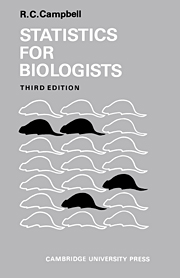Book contents
- Frontmatter
- Contents
- PREFACE
- PREFACE TO SECOND EDITION
- PREFACE TO THIRD EDITION
- 1 WHAT IS STATISTICS ABOUT?
- 2 PRESENTING THE INFORMATION CONTAINED IN ONE SAMPLE
- 3 COMPARING SEVERAL SAMPLES
- 4 ASSOCIATION
- 5 CHOOSING BETWEEN ACTIONS
- 6 THE NORMAL DISTRIBUTION
- 7 THE NORMAL VARIABLE IN EXPERIMENTS AND SURVEYS
- 8 ASSOCIATED NORMAL VARIABLES
- 9 SOME NON-NORMAL DISTRIBUTIONS
- FURTHER READING
- REFERENCES
- APPENDIX: TABLES AND FIGURES FOR STATISTICAL TESTS AND EXERCISES
- INDEX
2 - PRESENTING THE INFORMATION CONTAINED IN ONE SAMPLE
Published online by Cambridge University Press: 05 June 2012
- Frontmatter
- Contents
- PREFACE
- PREFACE TO SECOND EDITION
- PREFACE TO THIRD EDITION
- 1 WHAT IS STATISTICS ABOUT?
- 2 PRESENTING THE INFORMATION CONTAINED IN ONE SAMPLE
- 3 COMPARING SEVERAL SAMPLES
- 4 ASSOCIATION
- 5 CHOOSING BETWEEN ACTIONS
- 6 THE NORMAL DISTRIBUTION
- 7 THE NORMAL VARIABLE IN EXPERIMENTS AND SURVEYS
- 8 ASSOCIATED NORMAL VARIABLES
- 9 SOME NON-NORMAL DISTRIBUTIONS
- FURTHER READING
- REFERENCES
- APPENDIX: TABLES AND FIGURES FOR STATISTICAL TESTS AND EXERCISES
- INDEX
Summary
Pictorial presentation
The procedures discussed in chapter 1 had the purpose of making our sample of observations representative of the population we wished to investigate. We need now to consider what we can learn about the population from our sample. We require first to condense the information contained in the sample; even twenty observations are more than we can usefully comprehend without some form of summary.
The first and simplest form of summary should be a suitable pictorial presentation. There are many of these available, but we will consider only the more important types. The choice of the best type is partly a matter of objective judgement of the possible methods, but also depends on what features of the sample we consider important to our argument. This comment applies in varying degree to all statistical investigations and is on the one hand a challenge to our skill and understanding, but is also the origin of many misinterpretations—or worse! As soon as we summarize a sample, as every analysis does in one way or another, we decide what to emphasize and at the same time what to ignore. In presenting our own analyses and understanding other people's, we need always to be just as clear about what aspects of the sample have been passed over as we are about the meaning of the features emphasized. A most enjoyable account of some of the distortions which statistical methods can produce is given by Huff (1986).
Information
- Type
- Chapter
- Information
- Statistics for Biologists , pp. 13 - 60Publisher: Cambridge University PressPrint publication year: 1989
